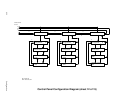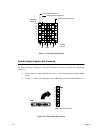
4–3Graphics
The relationship of ASCII character, decimal value, and Bit Image plot is shown in Figure 4–3.
• The
data bytes can be identified by their binary
, octal, hexadecimal, or decimal equivalents.
These
values are used to generate the Bit Image pattern.
• Bit
Image plotting is not limited to printable ASCII characters. Y
ou can plot Bit Image pat
-
terns for any 8–bit data byte with decimal values ranging from 0 to 255.
• The standard ASCII character chart and its equivalents are listed in Appendix A.
NOTE:
Bit Image Graphics is r
ecommended in the Data Pr
ocessing
print mode (120 x 72
dpi). V
ertical density variations in other print modes may cause white horizontal bars or
overlapping
of adjacent graphics
lines; however
, changing the line spacing can corr
ect this
problem.
=A65=
MSB
=
ASCII
CHARACTER
DECIMAL
VALUE
BINARY
CODE
EQUIVALENT
TO
VERTICALLY
ROTATED DATA
BYTE
BIT IMAGE
PATTERN
128
64
32
16
8
4
2
1
Figur
e 4–3.
Bit Image Pattern from an ASCII Character
Bit Image Density
Bit
Image
graphics can be printed in dif
ferent dot densities. Dot densities are selected by control code:
• Control
code ESC K
selects the
Single Density Mode.
Single
Density Bit Image graphics in the Data Processing print mode are printed at 60 dots
per inch (dpi) horizontally and 72 dpi vertically. In the Correspondence print mode, the
horizontal
dot density is 90 dpi and vertical dot density is 96 dpi. In the High Speed (HS)
mode, horizontal dot density is 60 dpi and vertical dot density is 48 dpi.
• Contr
ol code ESC L
selects the
Double Density Mode.
The
Double Density mode prints up to twice the number of dots
per inch horizontally in the
same
space as used for Single Density
. The vertical dot density remains
the same as in the
Single Density mode. Double horizontal density requires twice the number of input data
bytes
to print the same length line as for
Single Density
. Printing double density reduces the
printing
speed by half.
• If
each “1” or true bit is plotted, the result is a Bit Image plot of the ASCII character “A.”


















